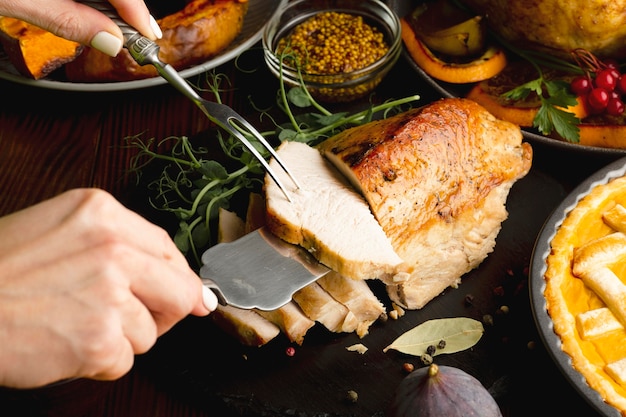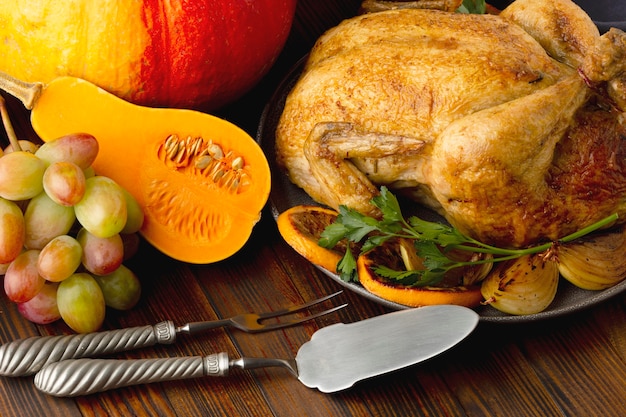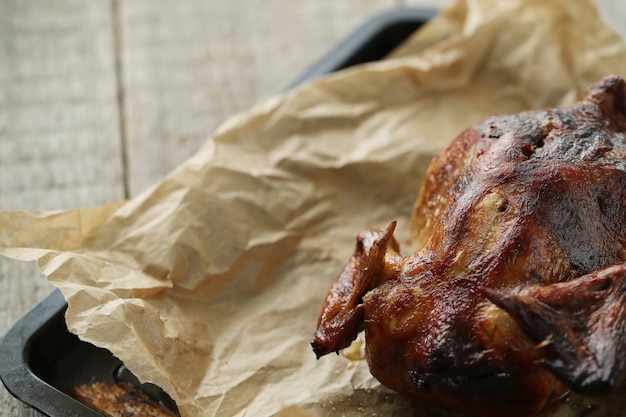There's something about the aroma of roast chicken filling your home that instantly evokes feelings of comfort and warmth. A perfectly roasted chicken, with its crispy skin and succulent meat, is a culinary triumph that can make any meal feel special. But achieving that perfect golden-brown, juicy bird can sometimes feel like a culinary puzzle. Fear not, my fellow food enthusiasts! I'm here to unravel the mysteries of roast chicken, sharing my tips and tricks for consistently creating a delicious masterpiece. Get ready to elevate your roast chicken game!
(Part 1) Getting to Know Your Bird

Before you even think about preheating your oven, you need to understand the star of the show: your chicken. This involves a little bit of detective work to ensure you're fully equipped to create the perfect roast.
Size Matters
Every chicken is unique, with sizes ranging from petite birds to colossal ones that could feed a small army. A 1.5 kg chicken will cook much faster than a 2.5 kg behemoth. So, the first step is to weigh your chicken, as this will be crucial for determining the ideal cooking time.
Chicken Anatomy
Next, examine your chicken's anatomy. Is it a whole chicken, or are you working with individual pieces? Is there a package of giblets tucked inside? Understanding these details will help you make informed decisions about cooking time and temperature. chicken pieces like breasts or thighs will cook much faster than a whole bird.
Oven Compatibility
Finally, consider your oven's personality. Every oven is unique, with some running hotter than others. Understanding your oven's quirks is crucial for achieving consistent results. If you have an older oven that doesn't heat evenly, you might need to adjust cooking times slightly and rotate the chicken midway through for even browning.
(Part 2) The Art of Prepping: Pampering Your Bird

Now that you've gotten to know your chicken, it's time to give it a little pampering before its grand entrance into the oven. These prepping steps will make all the difference in achieving a truly remarkable roast.
Brining: A Flavorful Soak
Brining, a culinary magic trick, involves submerging your chicken in a salty solution for a few hours. This simple act transforms the chicken, infusing it with moisture and flavour, resulting in a juicy, succulent bird that even the most discerning foodie would approve of.
There are two main methods of brining:
Dry Brining: This method involves rubbing the chicken with a salt mixture and leaving it uncovered in the refrigerator for several hours. The salt draws moisture from the chicken, creating a flavorful crust and ensuring a juicy interior.
Wet Brining: This method involves submerging the chicken in a saltwater solution for several hours. The salt permeates the meat, resulting in a juicy and flavorful chicken.
I'm personally a huge fan of dry brining, as it gives the chicken a lovely, crispy skin. But even a quick 30-minute wet brine can significantly improve the chicken's flavour and texture.
Pat it Dry for a Golden Glow
After brining, it's crucial to pat the chicken thoroughly dry. This seemingly minor detail is essential for achieving that beautiful golden-brown skin. A wet chicken won't brown properly in the oven, and it could even lead to steam buildup, making the skin soggy. Grab some kitchen paper and pat your chicken until it's completely dry.
Seasoning with Love
Now, it's time to season your chicken with love and care. I like to keep my seasoning simple, but feel free to experiment with different herbs and spices.
Salt and pepper are the essential staples, enhancing the natural flavour of the chicken.
Dried herbs like rosemary, thyme, and oregano add a beautiful aroma and depth of flavour.
Garlic powder, paprika, and onion powder add a touch of warmth and complexity.
Don't be afraid to get creative! A pinch of cayenne pepper for a touch of heat, or a sprinkle of lemon zest for a bright citrusy flavour, can add another layer of deliciousness. The possibilities are endless!
Ready for the Oven
Finally, it's time to get your chicken ready for its grand entrance into the oven. Preheat your oven to 200°C (400°F), ensuring even cooking and a beautiful golden-brown crust. Then, choose between roasting the chicken on a rack over a baking sheet or directly on a baking sheet. The rack method allows for better air circulation, resulting in a crispier skin. But if you're short on time, a baking sheet works just fine.
(Part 3) Mastering the Oven Time: The Chicken's culinary journey

This is where the magic happens - determining the perfect cooking time for your roast chicken. Remember, every chicken is unique, and cooking times can vary depending on size and weight. But with a little know-how, you can consistently nail the perfect roast.
A Rule of Thumb
A good rule of thumb is to allow 20 minutes of cooking time per 500g (1 lb) of chicken. So, a 1.5 kg chicken would need about 60 minutes in the oven. However, this is just a guideline. You'll need to consider factors like the size and shape of your chicken, your oven's temperature, and your personal preference for how well you like your chicken cooked.
The meat thermometer: Your Reliable Guide
For the most accurate results, it's always a good idea to use a meat thermometer. Insert the thermometer into the thickest part of the thigh, making sure it doesn't touch any bone. A properly cooked chicken should have an internal temperature of 74°C (165°F) or above.
If you're not using a thermometer, check the chicken's doneness by piercing the thickest part of the thigh with a fork. The juices should run clear, not pink. The thigh should also feel firm, not squishy.
Avoiding Overcooking: A Culinary Tragedy
Remember, overcooked chicken is a culinary tragedy. It's dry, tough, and frankly, not very enjoyable. It's better to err on the side of caution and undercook the chicken slightly than overcook it. If you're unsure, take the chicken out of the oven a few minutes early and check its temperature. You can always pop it back in for a few more minutes if necessary.
(Part 4) Rest and Revelation: A Moment for the Chicken to Catch its Breath
You've patiently waited, the delicious scent of roast chicken wafting through your home. The golden-brown crust is glistening, and you're ready to carve into your culinary masterpiece. But before you grab your carving knife, there's one crucial step you shouldn't skip: letting your chicken rest.
The Importance of Rest
Resting your chicken is like giving it a chance to catch its breath after its journey through the oven. It allows the juices to redistribute throughout the meat, ensuring that the chicken is juicy and flavorful. Resting for 10-15 minutes is ideal.
Carving Perfection
Now, it's time for the grand reveal! Grab your carving knife and a cutting board, and prepare to carve your chicken with precision and care.
Start by carving the legs from the body of the chicken.
Next, separate the breasts from the carcass, being careful not to tear the meat.
If you're working with a whole chicken, you can then carve the wings from the carcass.
Don't forget to save the bones for making a delicious stock!
(Part 5) Sides That Sing: The Perfect Accompaniments
No roast chicken is complete without a symphony of delicious sides. The perfect accompaniment will elevate your meal to new heights of culinary glory. Here are a few of my favourite side dishes to pair with a roast chicken:
roast potatoes: A Classic for a Reason
What's a roast dinner without crispy, golden roast potatoes? They're a classic for a reason! Their crispy exterior and fluffy interior make the perfect contrast to the juicy chicken.
Roasted Vegetables: A Burst of Flavor and Color
Roasted vegetables add vibrant colour and a burst of flavour to your roast chicken feast. Try roasting root vegetables like carrots, parsnips, and sweet potatoes for a sweet and earthy flavour.
green beans and Peas: A Refreshing Contrast
Green beans and peas provide a refreshing contrast to the richness of the roast chicken and potatoes. Their delicate flavour adds a welcome lightness to the meal.
Gravy: The Finishing Touch
No roast dinner is complete without a generous helping of gravy. Make your gravy from the chicken pan drippings for the ultimate flavour boost! The drippings are packed with the essence of the roast, creating a gravy that's truly irresistible.
(Part 6) Roast Chicken Variations: A culinary adventure
Now that you've mastered the basics of roast chicken, let's get creative! Here are a few variations to add a touch of excitement to your next roast chicken dinner:
Lemon and Herb Chicken: A Vibrant Twist
Add a vibrant twist to your chicken by rubbing it with lemon zest and fresh herbs like rosemary, thyme, and oregano. The citrusy notes and fresh herb flavours will transform your roast chicken into a culinary delight.
Garlic and Rosemary Chicken: A Classic Combination
This classic combination is sure to please. Stuff the chicken cavity with garlic cloves and rosemary sprigs for a flavour-packed experience. The rich aroma of garlic and rosemary will infuse the chicken with an irresistible flavour.
Honey Mustard Chicken: Sweet and Tangy Delight
For a sweet and tangy flavour, brush the chicken with a honey mustard glaze before roasting. The sweet honey and tangy mustard create a delectable glaze that adds a touch of sophistication to your roast.
Spiced Chicken: A Journey of Flavor
Add a touch of heat and complexity to your roast chicken by using a blend of spices like cumin, paprika, and coriander. The warm spices will create a depth of flavour that will tantalize your taste buds.
(Part 7) Troubleshooting: When Things Go Wrong
Even the most seasoned cooks can have a culinary mishap from time to time. So, if your roast chicken doesn't turn out quite as you expected, don't despair! Here are a few troubleshooting tips to help you get back on track:
Dry Chicken: The Culinary Crime
If your chicken is dry, it's likely that it was overcooked. Next time, check the chicken's temperature earlier and take it out of the oven when it reaches an internal temperature of 74°C (165°F). Remember, it's better to err on the side of caution and undercook slightly.
Soggy Skin: A Dampener of Delight
Soggy chicken skin is often a result of not patting the chicken dry before roasting. Make sure to pat your chicken thoroughly with kitchen paper before placing it in the oven.
Unevenly Cooked Chicken: A Case of Uneven Heating
If your chicken is cooked unevenly, it's likely that your oven wasn't heated evenly. Try rotating the chicken halfway through the cooking process to ensure even cooking.
(Part 8) FAQs: Your Roast Chicken Questions Answered
Now that you've learned everything you need to know about roast chicken, you might be brimming with questions. Don't worry, I've got you covered!
1. Can I Roast a frozen chicken?
While it's possible to roast a frozen chicken, it's not recommended. Frozen chicken takes much longer to cook, and it's harder to ensure that it cooks evenly. It's best to thaw the chicken completely in the refrigerator before roasting.
2. What's the Best Way to Store leftover roast chicken?
Leftover roast chicken can be stored in an airtight container in the refrigerator for up to 3 days. You can also freeze it for up to 3 months. Just make sure to wrap it tightly in plastic wrap or aluminum foil before freezing.
3. Can I Reuse the Chicken Pan Drippings to Make Gravy?
Absolutely! The chicken pan drippings are packed with flavour, and they're the perfect base for a delicious gravy. Simply skim off any excess fat, then add the drippings to a saucepan with some flour, water, and seasonings. Bring the mixture to a simmer and cook until the gravy thickens.
4. What Are Some Good Sides to Serve with Roast Chicken?
The best sides to serve with roast chicken are those that complement its flavour and texture. Some classic choices include roast potatoes, roasted vegetables, green beans, peas, and gravy.
5. What Are Some Tips for Getting crispy chicken Skin?
To achieve crispy chicken skin, pat the chicken dry before roasting, and cook it on a rack over a baking sheet. This will allow for better air circulation and prevent the skin from becoming soggy. You can also baste the chicken with melted butter or oil during the cooking process to help crisp up the skin.
Conclusion
There you have it, my friends! The secrets to achieving the perfect roast chicken. Follow these tips, and you'll be on your way to creating culinary masterpieces that will impress even the most discerning palates. So, gather your ingredients, put on your apron, and get ready to unleash your inner chef!
Everyone is watching

How to Cook Frozen Lobster Tails Perfectly: A Step-by-Step Guide
RecipesLobster. Just the word conjures up images of lavish meals, special occasions, and a taste of luxury. But let's...

Pigs in a Blanket Cooking Time: How Long to Bake for Perfect Results
RecipesAh, pigs in a blanket. Just the name conjures up images of those delightful little parcels of crispy pastry en...

Pork Fillet Cooking Time: How Long to Cook It Perfectly
RecipesPork fillet, or tenderloin as it's sometimes called, is a real favourite in our house. It's so versatile, and...

The Ultimate Guide to Cooking Delicious Frankfurters
RecipesLet's face it, we all love a good frankfurter. It's a classic, simple, and always satisfying. But let's be rea...

Wolf Meat Recipes: A Guide to Cooking Wild Game
RecipesLet's be honest, you don't see wolf meat at your local butcher shop every day. It's a bit of a wild card, but ...
